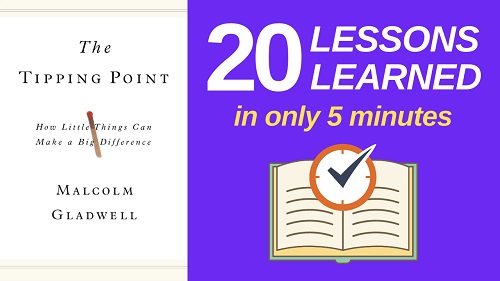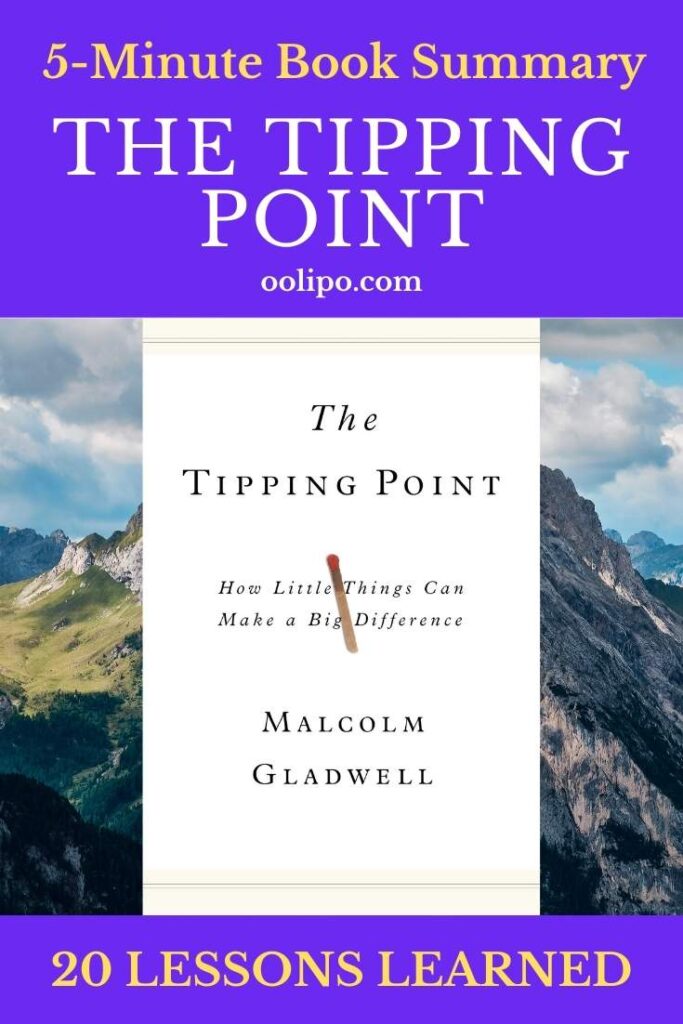The Tipping Point: How Little Things Make a Big Difference is a self-help book written by Malcolm Gladwell in 2000. In this The Tipping Point summary, we dive deep into Gladwell’s perspective on conversations and communities.
An idea can spread just like a virus. One idea can change the world. Would you like to know how such ideas emerged and spread? In his book, Malcolm Gladwell describes the conditions for the spread of an idea, the characteristics of the idea to be spread, and how it has driven millions of people.

The Tipping Point Summary with 20 Lessons Learned
Here are the 20 lessons to learn from The Tipping Point Summary:
#1 Like Viruses
Malcolm Gladwell says that ideas, people’s dispositions, all thoughts, rational or absurd, behave like a virus. Such currents, which turn into a biological epidemic, can reach the other end of the world in an instant.
#2 A Few People
An idea does not have to be accepted by many people at once for it to turn into an epidemic. A few people are enough in the beginning. If these are the right people, it doesn’t take long for larger crowds to encounter and embrace this idea.
#3 The Life of the Virus
For an idea to spread, it doesn’t have to be attractive enough to stay in people’s minds for very long. It is enough for a person to keep that idea in his mind until he transfers it to another person. A virus that is catchy enough can spread. A very attractive but easily forgotten idea does not spread.
#4 Freedom
The more freely people have the opportunity to express their thoughts in a community, the faster the ideas have found the ground to spread. It doesn’t matter how perfect the non-transferable idea is.
#5 Audience
It is more beneficial to infect someone who can reach thousands of people alone than to spread the idea among 100 people who cannot reach other people. The idea spread extremely quickly if it infected someone with a chance to call out to thousands of people.
#6 Details
Small changes can make big differences. A small accessory used by a fashion icon or a word uttered by the protagonist of the movie can be adopted and used by everyone at once. The more value a person sees, the more effective a small action can be.
#7 Pressure
For the idea to have an impact that can reach millions of people at once, it must first be under pressure. People who hear this idea may not be able to express it much at first and may cause it to spread with their opening later. Especially if this is a forbidden thought, it will have a bigger explosion.
#8 Minority Takes Care
A minority of people make the greatest spread of an epidemic. The majority infect fewer people. The 80/20 rule in trading seems to apply here as well. Most of the income comes from the minority.
#9 Small Parts Can Grow
An idea may not see much value at first. Its features may not attract much attention. But once it has developed and spread, its features that do not attract much attention this time begin to attract attention. The simplicity of the original idea does not mean that it cannot evolve.
#10 Burst Point
You don’t need to strive for the idea to reach millions of people. The point where you should strive to spread the idea is only the part until the moment of explosion. After that, it moves out of control like a forest fire. All you’ve got to try to do is watch the fire.
#11 Creativity
For an idea to spread, it must be understandable, but not in the commonplace that people are familiar with. Here you have to use your creativity. It should grab their attention the first time they hear it. Maybe they should feel that something is going to change.
#12 No Guarantee
You cannot control people. Also, an idea that came out at the same time as yours may be more successful. No matter how good your idea is, it can be overshadowed by other ideas. Deliver your idea to as many people as you can until the last moment.
#13 Sure It Will End
No matter how great an idea is, no matter how many people it has influenced, it will one day be lost. All ideas fade over time. Don’t try to fight it. Everything gets old. People get bored.
#14 Duration of Outbreaks
There is a certain period when every idea that is spread will be accepted among the people. If the idea somehow manages to develop, it can maintain its permanence. But all ideas that do not update themselves are forgotten.
#15 Longing for the Past
If it’s been too long since your idea, people may yearn. They can make that idea popular again by saying that there was once such a thing. The reason for this is that no new idea has come in.
#16 Positive Ideas
Ideas that create positive feelings in people spread more quickly. Although journalism is about negative events, the spread of ideas is going in the opposite direction. People prefer to share fun things.
#17 Being Tryable
People transfer more ideas to each other that they can try on themselves and get results. Ideas that work for them, meet expectations and get immediate results can spread much faster.
#18 Original Ideas
Unique ideas are more appealing to them than ideas that are creative but not surprising. They get more excited when they pass on information that has not been heard before. Sometimes it can even be said that they compete to be the first to convey this information.
#19 Latecomers
Some people just don’t like new ideas. No matter how useful and viable the idea is, people who are closed to innovation and change can ignore it. Late adopters still have a benefit. Because once they accept the innovation, they do not change for a long time.
#20 Skills in Selling Ideas
An idea or product needs to be well packaged at the outset. Maybe it has to have a story underneath and with it to affect people emotionally. Emotionally connected ideas are the strongest.
Top 10 Quotes from The Tipping Point
1. “Epidemics are a function of the people who transmit infectious agents, the infectious agent itself, and the environment in which the infectious agent is operating.”
2. “This idea of the importance of stickiness in tipping has enormous implications for the way we regard social epidemics as well.”
3. “The key to getting people to change their behavior, in other words, to care about their neighbor in distress, sometimes lies with the smallest details of their immediate situation.”
4.” Real estate salesmen know more people than computer hackers. What was surprising, though, was how enormous that range was.”
5. “The reason we don’t send birthday cards to people we don’t really care a great deal about is that we don’t want to feel obliged to have dinner with them or see a movie with them or visit them when they’re sick.”
6. “This principle holds for more than just jobs, of course. It also holds for restaurants, movies, fashion trends, or anything else that moves by word of mouth.”
7. “If you can track where someone’s fovea is moving and what they are fixating on, in other words, you can tell with extraordinary precision what they are actually looking at and what kind of information they are actually receiving.”
8. “If you make a beer loy commercial with a beautiful model, it would be really important to know whether the average twenty-two-year old male in your target audience fixates only on the model or eventually moves to your can of beer.”
9.” The economy’s dramatic recovery meant that many people who might have been lured into crime got legitimate jobs instead, and the general aging of the population meant that there were fewer people in the age range — males between eighteen and twenty-four — that is responsible for the majority of all violence.”
10. “People with stunted psychological development don’t understand how to conduct healthy relationships. People with genetic predispositions to violence fly off the handle when normal people keep their cool.”
Free PDF Download of The Tipping Point Summary to Save or Print
We created a PDF file with the summary and quotes on this page for easy access: Download The Tipping Point PDF Summary. If you want to buy the paperback version of the book, check out this page.
Malcolm Gladwell’s Takes on Underdogs
Please share these important lessons by pinning this post to Pinterest.
